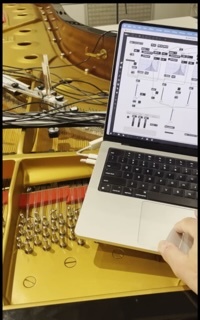Dans le cadre de la fin de résidence musicale des compositeurs Per Bioland (Université de Miami, Ohio) et Richard Causton (université de Cambrige, Royaume Uni) Henri Boutin de l’équipe S3AM nous invite à une présentation de leur travail portant sur le contrôle Actif de cordes de piano à l’aide de transducteurs électromagnétiques.
Résumé
Contrôle Actif de cordes de piano à l’aide de transducteurs électromagnétiques
Le contrôle actif permet d'attribuer des caractéristiques temporelles et fréquentielles souhaitées aux structures vibrantes. Appliquée aux instruments de musique, cette technique leur permet de produire de nouveaux sons rayonnés par leur propre structure vibrante, contrairement aux effets sonores appliqués aux enregistrements, qui sont généralement rayonnés par des haut-parleurs.
Dans le cadre de cette résidence musicale, la collaboration entre Per Bloland, Richard Causton, compositeurs, et Henri Boutin, chercheur du laboratoire STMS, avait pour objectif de produire de nouveaux sons de piano à l’aide transducteurs électromagnétiques.
La première étape du projet a consisté à envoyer des signaux synthétisés avec MaxMSP aux actionneurs, placés à proximité des cordes du piano, afin de provoquer leur vibration et celle de la table d’harmonie.
La seconde étape avait pour objectif de contrôler la vibration du système complexe, composé d’un cœur de cordes de piano, frappées par le même marteau, couplées entre elles et à la table d'harmonie. Pour cela, un contrôleur a été placé dans une boucle de rétroaction entre un capteur et un actionneur électromagnétiques, dont le positionnement à proximité du cœur de cordes a fait l’objet d’une étude préliminaire. Le contrôleur se compose d’une somme de filtres passe-bandes d’ordre 2. Leurs paramètres sont choisis à partir d’une mesure de la fonction de transfert du système, pour attribuer indépendamment l’amplitude et la fréquence souhaitées à chacun des partiels rayonnés. Ce contrôleur a initialement été implanté sur une carte de prototypage dSPACE MicroLabBox, offrant l’avantage de réduire la latence à une période d’échantillonnage. Il a ensuite été implémenté avec MaxMSP dans un ordinateur, introduisant une latence plus élevée mais plus adapté à la performance musicale.
Cette présentation permettra de diffuser en studio 5 les sons obtenus lors des deux étapes du projet sur le piano de concert Steinway D de l’Ircam.

Biographies
Per Bloland est un compositeur de musique acoustique et électroacoustique dont les œuvres ont été saluées par le New York Times comme étant « luxuriantes, caustiques » et « irrésistibles ». Ses compositions vont de courtes pièces solos intimes à des œuvres pour grand orchestre. Elles intègrent de la vidéo, de la danse et de l'électronique personnalisée et s'inspirent souvent d'autres formes d'art. Bloland s'intéresse particulièrement aux intersections entre la littérature et la musique, notamment en ce qui concerne les questions de modernité dans ces deux disciplines. En 2013, les œuvres de Bloland ont été sélectionnées pour être jouées lors des Journées mondiales de la musique nouvelle de la Société internationale de musique contemporaine (ISCM) en Slovaquie. Son premier opéra, Pedr Solis, a été commandé par Guerilla Opera en 2015, et a reçu des critiques élogieuses du Boston Globe et du Boston Classical Review.
Bloland a participé à la création de l'Electromagnetically-Prepared Piano, et composé un certain nombre de pièces pour cet instrument [ICMC-2007] et créé le site web magneticpiano.com. Sur la base de ces travaux, sa première résidence de recherche musicale à l'IRCAM a porté sur la création d'un modèle physique du couplage entre un résonateur (tel qu'une corde de piano) et un électro-aimant. Le projet actuel porte sur la mise en œuvre d'un système de contrôle actif de type feedback afin d'élargir encore les possibilités timbrales du piano.
Richard Causton a été décrit comme « l'un des artistes en activité les plus courageux et les plus intransigeants». Sa musique a été jouée dans le monde entier, notamment au Lincoln Center, au Concertgebouw et au South Bank Centre de Londres. Il a travaillé avec des ensembles tels que le BBC Symphony Orchestra, le City of Birmingham Symphony Orchestra, Sinfonieorchester Basel, Rundfunk-Sinfonieorchester Saarbrücken, London Sinfonietta, le Birmingham Contemporary Music Group et l'Ensemble Recherche. Ses œuvres sont enregistrées chez Metier, Orchid et NMC. Son oeuvre Ik zeg : NU (2019) est l'une des deux œuvres sélectionnées par la BBC pour représenter le Royaume-Uni à la Tribune internationale des compositeurs (International Rostrum of Composers). La terra impareggiabile a été sélectionné pour un Gramophone Award. Outre ses activités de compositeur, Richard diffuse occasionnellement des émissions pour la radio italienne (RAI Radio 3). Il est actuellement professeur de composition à l'université de Cambridge.
Henri Boutin est chercheur en acoustique musicale et en contrôle actif appliqué aux instruments de musique, au sein de l’équipe S3AM du laboratoire STMS à l’Ircam. Après une formation d’ingénieur (ENSEA) et le master ATIAM (Sorbonne-Université, Telecom ParisTech et Ircam), il s'est spécialisé dans le traitement du signal et l'acoustique appliqués à la musique. Sa these conçoit des méthodes pionnières de contrôle actif modal destinées à modifier le son du violon et d’une lame de xylophone, à l'aide de transducteurs piézoélectriques. Ses recherches actuelles portent sur la conception de solutions de contrôle actif adaptatif feedback et feedforward à des fins acoustiques, musicales et de conservation, en collaboration avec des compositeurs et des musées. Il est également impliqué dans des projets sur l'acoustique des instruments de musique et de la voix humaine, en collaboration avec des partenaires nationaux et internationaux. Henri Boutin est également co-directeur de la licence d’électronique à la faculté d’ingénierie de Sorbonne Université, où il enseigne le traitement du signal et l'électronique en Licence et Master